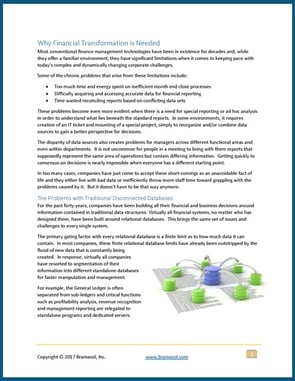As companies undertake Financial Transformation to improve their ability to be nimble, react quickly and take advantage of market trends, several key things are emerging:
- Drive to continuous close
- Consolidation of data source for reporting
- Improved visibility for compliance with new standards for Revenue Recognition, Leasing and Financial Impairments
- Real-time cash management
Some of the key Financial Transformation opportunity areas include:
- New-generation architectures, such as SAP S/4HANA, that combine core ERP & Finance systems with plug-in modular best-of-breed capabilities for revenue recognition, leasing, ecommerce, HR, travel, supply chain management, and more.
- A “single version of the truth” approach that avoids discussions of who’s data is right, thereby enabling much faster and better tactical decision-making.
- Cloud-based implementation options that can greatly reduce time-to-operation and which integrate seamlessly with in-house implementations to enable cost optimization along with flexibility and scalability to support growth.
- Advanced real time analytics and user interface (UX) technologies that can access information throughout the unified systems and provide easily tailored comprehensive reporting for ongoing management or ad hoc decisions.
This new eBook, "The CFO's Guide to Financial Transformation" offers a deep dive into these challenges and opportunities along with a detailed discussion of the key actions that CFOs can take to effectively plan and implement company-wide financial transformation.

